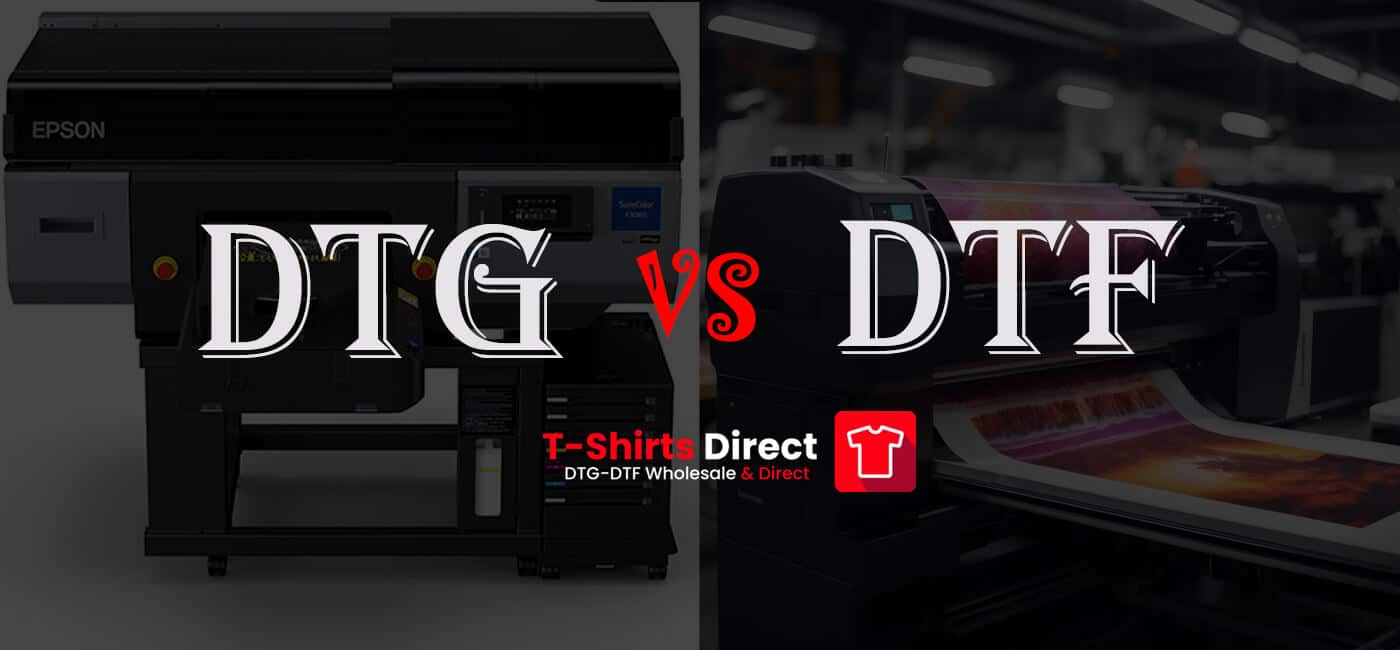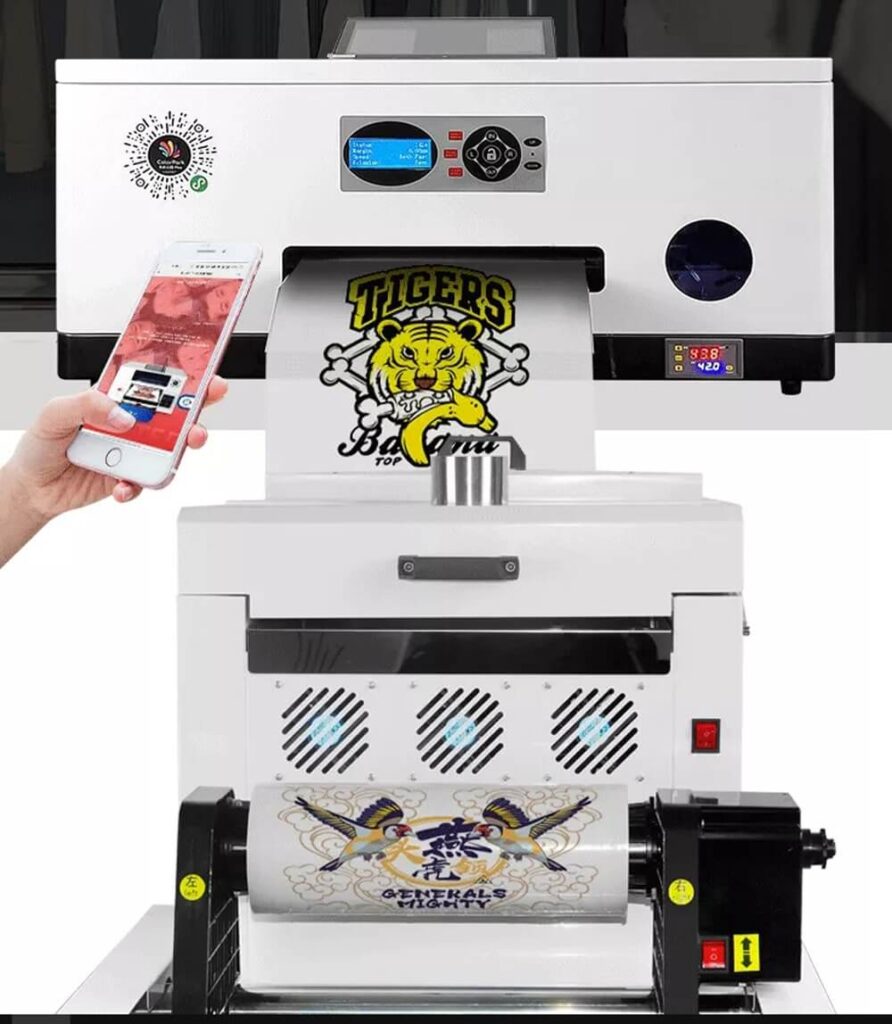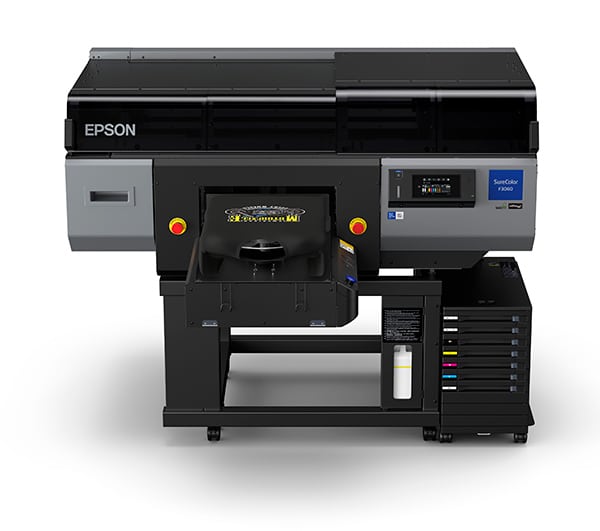
Actually, both direct-to-garment printing (DTG) and direct-to-film printing (DTF) are good at making detailed t-shirts, hoodies, and tote bags better than screen printing. However, there are some clear differences between DTG and DTF prints besides the different printing machines and techniques needed. Knowing about them can help you figure out which one fits your designs or brand the most, whether you’re starting a t-shirt business or just want to know more about printing methods.
So, what are the dissimilarities, benefits, and ideal uses of DTG versus DTF printing? Keep reading to find out everything about these printing methods.
What is DTF printing?
Direct-to-film (DTF) printing is a modern printing method that’s becoming more popular. It’s known for producing detailed and colourful prints that last well over time and look really good.
One of the great things about DTF printing is that it’s cost-effective. It doesn’t require a lot of money to produce prints, which is perfect for businesses looking to save on production costs. And the best part is, you can print on both light and dark-coloured garments, making it versatile for different designs.
The process of DTF printing involves a few steps, but it’s not too complicated. First, the design is printed onto a special transfer film using water-based inks. Then, a special adhesive powder is applied over the ink. Finally, the design is transferred onto the fabric using a heat press. Despite the multiple steps, it doesn’t take long to print one garment, usually just a few minutes.
What is DTG printing?
DTG (Direct-to-Garment) printing is a way of printing designs directly onto clothes. With this method, the ink is sprayed right onto the fabric, creating colourful and detailed prints. These prints feel soft, allow the fabric to breathe, and last a long time.
This type of printing works best on fabrics like cotton because these materials soak up the ink nicely. It’s a popular choice for making clothes on demand when you need them.
So, how does DTG printing actually work? First, a special solution is applied to the garment to help the ink stick to the fabric better. Then, the garment is put onto a machine, and the design is sprayed onto it using water-based inks. After that, the ink is dried to ensure the print stays on well.
One of the best things about DTG printing is that it’s easy to print just one item at a time. It only takes a few minutes to print a single t-shirt, and it doesn’t cost much either. That’s why a lot of people like using this method for making clothes.
Know more about DTG Trade Printing.
DTG vs DTF Printing
When deciding between DTG and DTF printing, there are many factors to weigh, including costs, production time, and personal preferences. Let’s take a closer look at how these two methods compare:
Cost:
The main thing to think about is the cost of the printing equipment. DTG printers typically range from $22,000 to over $70,000 for a good quality machine. However, they generally use more ink than DTF. On the other hand, DTF printers usually cost less than $15,000 and require less investment for inks.
However, there’s an alternative option: partnering with a print-on-demand service (POD). POD eliminates the need for you to invest in equipment or hold inventory. Your POD partner takes care of printing and packaging custom orders for you, saving you money on equipment costs.
Production Time:
When comparing DTG and DTF printing, it’s essential to consider the production time. DTG printing tends to be slower due to its two-step curing process. First, the DTG pretreatment solution must be cured, followed by curing the ink design. Using a forced air dryer instead of a heat press can further prolong the process.
On the other hand, DTF printing requires only one round of curing, which speeds up production. Additionally, DTF printers use a heat press to bond the design, which is quicker than using an air dryer. If time is a concern, partnering with a POD provider like T-Shirts Direct can expedite your order, with shipping typically taking four to seven business days!
Order Quantity:
When it comes to order quantities, both DTG and DTF printing are equally versatile. Unlike traditional screen printing, which may require large orders to be cost-effective, both DTG and DTF can handle orders as small as one t-shirt or as large as one thousand t-shirts. This flexibility is especially true when working with a POD service like T-Shirts Direct.
Print Color:
Next, let’s talk about print colour. Both DTG and DTF printing methods use the CMYK colour model, consisting of cyan, yellow, magenta, black plus white. However, there are some differences in how they handle colour.
Fabric Options:
The type of ink application used in DTF and DTG printing affects which fabrics are suitable for each method. DTF printing works well with various fabric types like polyester cotton lycra and more. For example, a Classic Unisex Pullover Hoodie made of preshrunk fleece knit fabric is perfect for DTF printing.
On the other hand, DTG printing is more limited in terms of fabric compatibility. Since DTG printing applies ink directly onto the garment, it works best with natural fabrics like cotton. For instance, heavyweight Premium Cotton Long-Sleeve T-shirts on any other cotton-based garments are suitable for DTG printing.
For DTF printing, white ink is always included as a base, which enhances the vibrancy of the transferred design, regardless of the garment colour. In contrast, DTG printing only uses a white base if the design is printed on a black or colourful garment. On light-coloured garments, DTG printing doesn’t use a white base.
Another difference is how the coloured ink is applied. With DTG printing, the ink is sprayed directly onto the garment. Therefore, DTG printing is best suited for full-colour or multi-colour prints for both light and dark fabrics.
Print Durability:
When considering the durability of prints, both DTF and DTG methods create long-lasting designs.
Sustainability:
Now, let’s talk about sustainability. Both DTF and DTG prints use water-based inks and offer small order quantities to reduce excess waste. However, DTF printing is more environmentally friendly. DTG printing consumes more white ink, impacting sustainability and profitability. In contrast, DTF uses less ink and printing materials overall, with little waste.
Print Intricacy:
When comparing print intricacy between DTG and DTF printing, it’s important to note that both methods offer high-quality prints, but there are some differences. While DTG printing may absorb ink, it doesn’t affect the precision of intricate designs. In fact, DTG printing is often preferred for its crisp details, whether you’re printing photos or intricate designs. On the other hand, with DTF printing, there may be a slight loss of precision as the design transfers from the film to the garment surface. Overall, DTG printing wins in the print quality category.
Print Comfortability:
Surprisingly, different printing methods can feel different against the skin. DTG printing applies ink directly to the garment without any fixing powder, resulting in a soft and lightweight feel. DTF printing uses a thinner layer of ink, so the garment feels just as light and comfortable.
Which process is better for you?
When to choose DTG printing
If you’re selling cotton garments or items made from natural materials, DTG printing is your best bet. It’s versatile, allowing you to print on apparel like t-shirts and accessories like tote bags, giving you plenty of options.
Direct-to-garment prints are durable and long-lasting, perfect for larger designs, and they allow the fabric to breathe. Just be sure to follow the instructions to maintain the print quality.
Since DTG printing is widely used worldwide, it’s a reliable option to consider. You can try this method to see if it meets your needs and expectations for your designs.
When to choose DTF printing
If your business focuses on selling items made from synthetic materials like polyester, nylon, or fleece, then DTF technology is the way to go. It’s also suitable for printing on various items like bags and hats, giving you more product options.
Choosing DTF is a good idea if your designs are detailed and colorful, and you prioritize high-quality printing. DTF prints always turn out vivid and sharp, and they are long-lasting.
Before selling items with DTF prints, it’s a good idea to order one for yourself and compare it with the same design fulfilled using different techniques. This way, you can ensure that the printing technique aligns with your expectations and business needs.
Create unique and detailed designs with T-Shirts Direct!
Our printing services ensure your designs pop with colour and precision, whether it’s intricate artwork or bold graphics. With our state-of-the-art technology, we bring your vision to life on high-quality t-shirts and other apparel. Experience durability and long-lasting prints that stand out from the crowd. Trust T-Shirts Direct for all your printing needs and make a statement with every wear!







